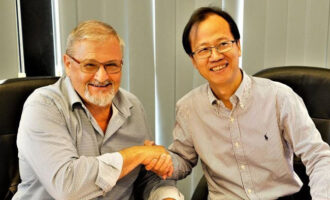
Honda Motor to electrify two-thirds of global auto unit sales by 2030
Striving to realize a carbon-free society, Honda Motor Co. Ltd. has set a goal to electrify two-thirds of its global automobile unit sales by 2030.
“When we talk about the introduction of electrified vehicles, there are two perspectives. One is the improvement of fuel economy, and the other is zero emissions. Regulations for the Corporate Average Fuel Economy (CAFE) standards are becoming increasingly stringent in every country around the world and complying with CAFE standards is one of the most important challenges for the automobile industry,” said Takahiro Hachigo, president and CEO, Honda Motor Co., Ltd.
He added that “we believe that hybrid technology is, at this moment, the most effective way for us to comply with CAFE standards,” in light of the required infrastructure and how people use automobiles. “Therefore, we will electrify our products mainly with hybrid technologies. By increasing sales of our hybrid models all around the world, Honda will contribute to the global environment through the improvement of fuel economy, Hachigo said.
Hachigo said that Honda will expand the application of our 2-motor hybrid system to the entire lineup of Honda vehicles. In addition to the 2-motor hybrid system which is compatible with mid-to-large-sized vehicles, Honda has developed a new, more compact 2-motor hybrid system suitable for small-sized vehicles. This small-sized 2-motor hybrid system will be adopted first by the all-new Fit which will premiere at the Tokyo Motor Show this fall.
In addition to the expansion of the lineup of products equipped with the 2-motor hybrid system, Honda also will expand the application of the 2-motor hybrid system on a global basis.
“By 2022, we are expecting to reduce the cost of the 2-motor hybrid system by 25% compared to the cost of this system in 2018,” Hachigo said.
As for zero emission vehicles, Honda will comply with the Zero Emission Vehicle (ZEV) program being adopted by California and other states in the U.S. and China’s New Energy Vehicle (NEV) mandate with battery EVs.
“We will efficiently introduce our battery EVs to the market by selecting the most appropriate partners and resources to satisfy the different needs in each region,” he said.
In North America, Honda will jointly develop battery components with General Motors and introduce highly-competitive battery EVs in the market.
In China, Honda has already begun introducing battery EV models developed together with local joint venture companies in China. “While envisioning the introduction of battery EV models from the Honda brand, we will continue utilizing local resources in China and introduce more battery EV models in a timely manner to fulfill local market needs in China.”
In Europe and Japan, the Japanese automaker will introduce the Honda e, a new battery EV model, which was recently introduced as a prototype at the Geneva Motor Show.
To summarize, Honda will popularize and improve the business feasibility of electrified vehicles by focusing on hybrid vehicles and battery EVs.
As for inter-regional coordination and collaboration, under the new operational structure adopted by Honda starting from last month, the company began reviewing and sharing the product lineup by grouping its six regions outside Japan based on a similarity of key factors, such as market needs and environmental regulations.
With this initiative, by 2025, Honda will reduce the total number of variations at the trim and option level for its global models to one-third of its current line-up. In addition, Honda will increase efficiency by eliminating and consolidating some similar regional models into even more competent models shared across multiple regions.









